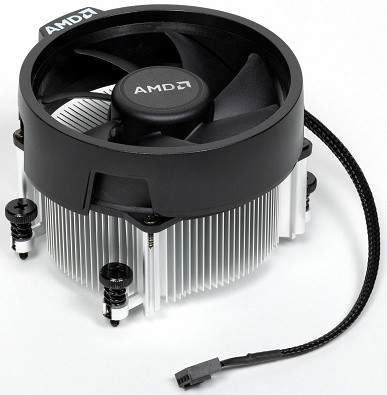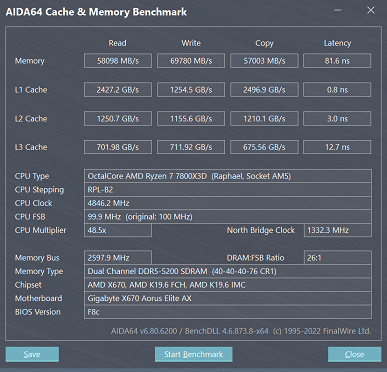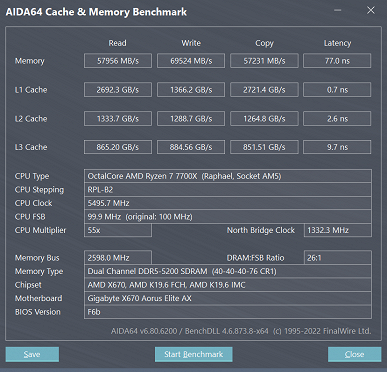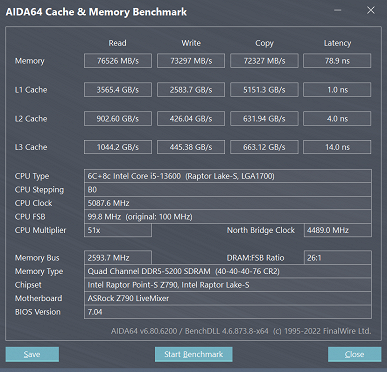AMD has introduced a new generation of APUs, or hybrid processors, for desktop computers. The Ryzen 8000G series is based on updated Zen 4 cores and RDNA 3 graphics architecture. These processors offer improved performance and power efficiency compared to previous models. Although they are designed for mobile devices, their architecture has been adapted for desktop use. The new Ryzen 8000G APUs promise to be one of the best solutions for budget desktop PCs thanks to their performance and affordable price.

AMD has unveiled a new generation of desktop APUs, including the Ryzen 8000G series. Using Zen 4 cores and RDNA 3 architecture graphics, these processors offer improved performance and functionality over previous models. They are designed for both mobile and desktop systems, exclusively on the AM5 platform.
The new Ryzen 8000G APUs provide the ability to play modern PC games at resolutions up to Full HD, albeit with some limitations on graphics settings. They also support AMD Hyper-RX technologies, including Radeon Super Resolution (RSR) and AMD Fluid Motion Frames (AFMF), making them an attractive choice for budget systems.
The flagship model of the series, the Ryzen 7 8700G, promises high performance and is able to compete with more expensive systems equipped with separate CPUs and discrete graphics cards. However, the question of price remains open, based on which the competitiveness of these new APUs in the market will be determined.
Ryzen 8000G Series: Heterogeneous Zen 4 Cores with Powerful Graphics
The Ryzen 8000G series APUs use Phoenix monolithic die technology, which was previously used in the Ryzen Mobile 7000/8000 series of mobile devices. AMD has divided the Ryzen 8000G series into two tiers: high-end, including the Ryzen 7 8700G and Ryzen 5 8600G, and more affordable, represented by the Ryzen 5 8500G and Ryzen 3 8300G.
The new APU series combines the core features of the desktop Ryzen 7000 with the features of the mobile Ryzen 8000 solutions. All models have a typical power consumption of 65 W, which provides them with reliable power reserve for desktop systems, allowing them to support higher clock speeds, especially in the case of the graphics core.
The new Ryzen 8000G APUs retain the benefits of previous models, delivering high performance and efficiency to both mobile devices and desktop computers.
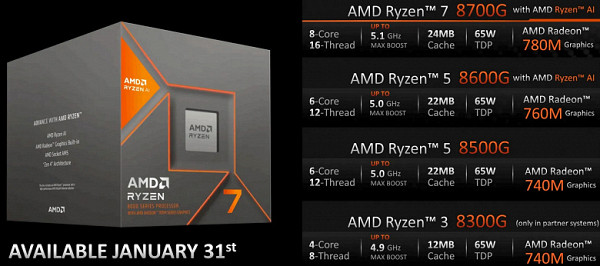
At the head of the family is the Ryzen 7 8700G — an eight-core APU based on Zen 4 cores, capable of running 16 threads thanks to SMT multi-threading technology. The processor supports hardware virtualization and AVX, AVX2, and AVX-512 instructions, making it compatible with Ryzen 7000 desktop processors and improving performance.
The flagship APU runs at a base frequency of 4.2 GHz and can reach a turbo frequency of 5.1 GHz, which is higher than the previous generation Ryzen 7 5700G based on Zen 3 cores. It also features a Radeon 780M graphics core with RDNA 3 architecture with improved software features such as Hyper-RX and Fluid Motion Frames. The Radeon 780M graphics core includes 12 CUs with 768 shader units and 1,536 stream cores operating at up to 2.9 GHz.
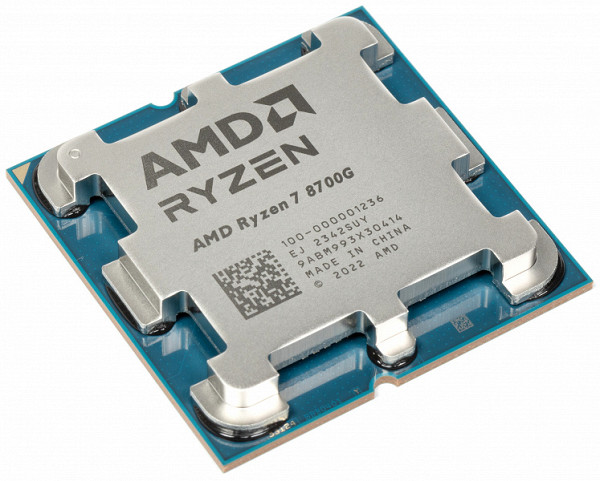
The Ryzen 8000G series APUs include the Ryzen 7 8700G and Ryzen 5 8600G, which are the first desktop processors to feature integrated artificial intelligence acceleration engines known as Ryzen AI. These blocks provide effective use in AI tasks, without claiming high computing performance. AMD acquired Ryzen AI technology through its acquisition of Xilinx in 2022 and now offers developers the choice of NPU, CPU or GPU depending on their needs and performance requirements.
The NPU in the Ryzen 7 8700G and Ryzen 5 8600G runs at 1.6 GHz, offering performance of around 16 TOPS for INT8. Although this value is slightly higher than that of mobile chips, it provides sufficient performance for laptops and desktops. Additionally, the overall combined CPU, GPU and NPU performance of these models is 39 TOPS.
Below the lineup is the Ryzen 5 8600G, which offers six full Zen 4 cores with a base frequency of 4.3 GHz and a maximum turbo frequency of 5.0 GHz. This APU is equipped with Radeon 760M graphics core with 8 CUs and a peak frequency of 2.8 GHz. In turn, the younger model Ryzen 5 8500G uses a Phoenix 2 crystal, combining two full-fledged Zen 4 cores and four energy-efficient Zen 4c cores, as well as a Radeon 740M graphics core with 4 CU units and a peak frequency of 2.8 GHz.
At the lowest end of the line is the Ryzen 3 8300G, which has one full Zen 4 core and three Zen 4c cores with a turbo frequency of up to 4.9 GHz. This APU also features Radeon 740M graphics core with four CUs.
As such, the new Ryzen 8000G APUs offer a variety of configurations and functionality, providing the optimal combination of performance and energy efficiency for different user needs.
| Cores, pcs. | Base frequency, MHz | Turbo frequency, MHz | GPU | GPU frequency, MHz | NPU | L3 cache, MB | Consumption, W | Price, $ | |
|---|---|---|---|---|---|---|---|---|---|
| Ryzen 7 8700G | 8 Zen 4 | 4200 | 5100 | 780M (12CU) | 2900 | + | 16 | 65 | 329 |
| Ryzen 5 8600G | 6 Zen 4 | 4300 | 5000 | 760M (8CU) | 2800 | + | 16 | 65 | 229 |
| Ryzen 5 8500G | 2 Zen 4 4 Zen 4c | 3500 | 5000 3700 | 740M (4CU) | 2800 | – | 16 | 65 | 179 |
| Ryzen 3 8300G | 1 Zen 4 3 Zen 4c | 3400 | 4900 3600 | 740M (4CU) | 2600 | – | 8 | 65 | OEM |
The Ryzen 7 8700G and 8600G dies use an advanced 4nm process technology, making them monolithic chips with an impressive number of transistors in a small footprint. This differs from the more common configuration of Ryzen 7000 desktop processors, which use a combination of 5nm compute dies and 6nm I/O dies. The Phoenix dies for the Ryzen 8000G are manufactured at TSMC's fabs, which is a new feature for AMD as they previously used in-house facilities for this.
The use of a monolithic chip with integrated graphics entails some changes, for example, in the amount of cache memory. For example, the 8700G has less cache than comparable Ryzen 7000 processors, which may impact performance under compute workloads.
Ryzen 8000G processors offer varying numbers of PCIe 4.0 lanes, which may impact external device connectivity. For example, older models have more PCIe lanes, which makes them more flexible in this regard.
Despite these differences, the Ryzen 8000G processors are supported by all AM5 platform chipsets, are multiplier unlocked for overclocking, and support DDR5 memory at high speeds. They also have integrated graphics and officially support various video output ports.
Overall, while there are differences between the Ryzen 7000 and Ryzen 8000G lines, they provide a similar set of features and capabilities for AM5 desktop systems.

Unlike the high-end Ryzen 7000 series processors, the Ryzen 8000G APUs come with complete system cooling. The maximum power consumption of the Ryzen 7 8700G does not exceed 88 W, which guarantees no cooling problems, even for the flagship model. The boxed version of this processor comes with a standard AMD Wraith cooler. It should also be noted that many AM4 socket coolers will also fit the new AM5 socket, but only if they use the native mount and backplate provided by AMD, rather than their own mounts, which is often the case with advanced air/air systems. liquid cooling.
However, you should not think that when using such a cooling system (or any other, for that matter), the operating temperatures of the hybrid processor will be very low. Here it is necessary to take into account not only the declared level of heat dissipation and the actual power consumption of the APU, but also the features of the new AM5 platform processors, which we previously mentioned. Unlike chiplet CPUs, a single APU chip does not have such a small area, but this does not exclude other disadvantages: the heat distribution cover is small in size and has shaped cutouts along the edges, which reduces the effective contact area with the heatsink. Moreover, this cover is quite thick, which significantly reduces the efficiency of heat transfer and cooling. Thus, even with a high-quality cooling system, new APUs will still get seriously hot.
RDNA 3 architecture integrated graphics and performance
Now let's move on to the most important aspect — the integrated graphics. The guiding principle behind AMD's new hybrid solutions is to be «game-ready right out of the box» — as long as Full HD (1920x1080 pixels) resolution is sufficient, as it remains the most common choice among gamers. While APUs are not designed to run modern high-end games at maximum settings, especially at this resolution, users will be able to enjoy medium settings in popular games or maximum settings in less demanding projects thanks to the power of the flagship APU's integrated graphics core.
Unlike the built-in graphics cores in the Ryzen 7000 series processors, which are absolutely the same in all models and are not powerful enough for modern games, APUs are distinguished by powerful GPUs, especially the top model. For example, the RDNA 2 GPU in the Ryzen 7 7700 has just a couple of CUs clocked at 2.2 GHz, while the 8700G has an RDNA 3 GPU with 12 CUs clocked at up to 2.9 GHz. This guarantees a significant performance boost for the 8700G's integrated graphics. So, while the two compute units in the Ryzen 7000 processors are clearly not enough to run modern games, the 12 RDNA 3 CUs in the Ryzen 7 8700G already represent a serious step forward, providing a relatively comfortable gaming experience.
In addition, the introduction of the RDNA 3 architecture graphics core into the APU brought new technologies that were not supported in the previous series of APUs. For example, AMD's Hyper-RX package includes Radeon Super Resolution upscaling, Anti-Lag+ technology, Radeon Boost, and AMD Fluid Motion Frames (AMFM). These technologies can be activated with one click and provide the user with the ability to customize the trade-off between performance and image quality according to preferences and requirements.
However, be aware that even with Hyper-RX technologies and powerful graphics enabled, the performance of new APUs may be lower than that of a processor and discrete graphics card combination such as the Core i5-13400 and GeForce GTX 1650. Enabling these technologies may change the resolution for some games to provide sufficient performance, but may result in reduced image quality. However, for most players, the integrated graphics power in the new APUs will be quite sufficient for a comfortable gaming experience.
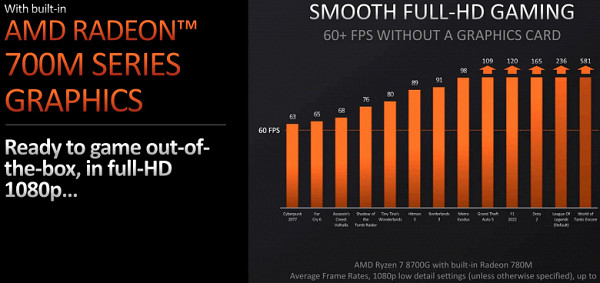
In any case, the Ryzen 7 8700G APU provides basic Full HD gaming at 60 FPS and above, even when using low graphics settings — AMD provides a corresponding chart where even Cyberpunk 2077 shows 63 FPS. In our opinion, in many games you can increase the graphics settings to at least medium in order to get, if not stable 60 FPS always, then at least enjoy high-quality graphics in modern games — this is what discrete video cards are usually purchased for.
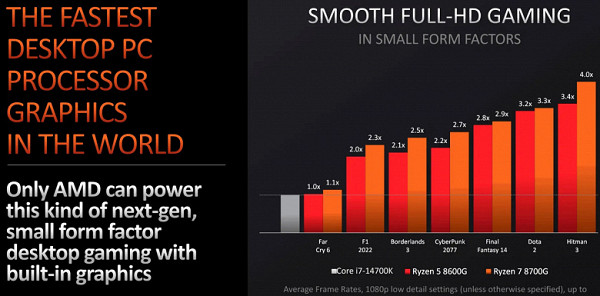
Further, specialists from the company compared the top models Ryzen 7 8700G and Ryzen 5 8600G with the Intel Core i7-14700K processor, which has a built-in UHD Graphics 770 graphics core based on the outdated Xe-LP architecture. The new Alchemist architecture, on which the integrated GPUs will be based, has not yet been presented. According to AMD, even the Ryzen 5 8600G model outperforms the Core i7-14700K by almost three times or more — in games with low graphics settings and Full HD resolution, and the flagship 8700G is even stronger than its competitor, almost four times. This declares a potential win and highlights the APU's ability to replace not only the CPU, but also the discrete GPU.
Performance testing
Test systems and conditions
- Processors:
- AMD Ryzen 7 8700G (8 cores/16 threads, 4.2 — 5.1 GHz)
- AMD Ryzen 7 7800X3D (8 cores/16 threads, 4.2 — 5.0 GHz)
- AMD Ryzen 7 7700X (8 cores/16 threads, 4.5 — 5.4 GHz)
- Intel Core i5-13600K (6P+8E cores/20 threads, 3.5—5.1 GHz)
- Intel Core i5-13400F (6P+4E cores/16 threads, 2.5—4.6 GHz)
- Cooling system: AeroCool Mirage L360 (LCS 3×120 mm, 2300/1800 rpm)
- Motherboards:
- Gigabyte X670 Aorus Elite AX (AM5, AMD X670)
- ASRock Z790 LiveMixer (LGA1700, Intel Z790)
- RAM:
- 32 GB (2x16 GB) DDR5-5200 CL40 G.Skill Ripjaws S5 (F5-5200U4040A16GX2-RS5W)
- Video card: Sapphire Nitro+ Radeon RX 6800 XT (16 GB)
- Drive: Kingston KC2000 SSD 2 TB (SKC2000M8/2000G)
- Power supply: Chieftec Polaris Pro 1300 (PPX-1300FC-A3) (80 Plus Platinum, 1300 W)
- Operating system: Microsoft Windows 11 Pro (22H2)
For testing, we used high-performance motherboards for each of the competing platforms, equipping them with a sufficient amount of RAM operating at close to the optimal frequency — within the capabilities of the available memory modules. For Ryzen 7000 series processors and Intel solutions of the last two generations, this was DDR5-5200 memory, and the memory settings on all systems were taken from XMP profiles. Power consumption limits were based on processor specifications rather than motherboard manufacturer settings.
Unfortunately, we did not have the opportunity to test the previous generation APU, but the tests involved two desktop eight-core processors from the modern AMD family: the Ryzen 7 7800X3D gaming processor and a similar model without additional L3 cache — the Ryzen 7 7700X. This will allow you to evaluate the impact of cache size and clock speed on performance in various tasks. We also took a couple of Intel processors for comparison: the Core i5-13600K and the Core i5-13400F. The APU in question should be somewhere between them in terms of computing performance.
For most of the tests, we used a previous-generation AMD graphics card, since we didn't have access to the newer Radeon and GeForce models when we started the series of tests several years ago. The Radeon RX 6800 XT delivers plenty of performance for lower resolutions and delivers faster rendering times than competing Nvidia models of the same era. However, in the future we plan to switch to using the GeForce RTX 4080 for testing gaming loads with discrete graphics.
Synthetic tests
Memory and caching performance
In terms of DDR5 memory bandwidth used by the Ryzen 7000 and 8000G, the difference between the CPU and APU should not be particularly noticeable, although there may be some surprises due to the monolithic structure of today's APU. There has been a noticeable increase in the speed of writing and copying from memory, but the read speed remains at the same level — compared to a similarly priced Intel processor. Although the older Core i5 model is inferior only in writing, it remains ahead in reading and copying speed. The efficiency of the DDR5 controller in AMD's monolithic chip is slightly better than in chiplet solutions, but on average it is still lower than that of Intel processors, judging by the results of specialized memory tests from the AIDA64 and Sandra packages.
In this case, the same conditions were used for all processors — DDR5-5200 memory operating mode. However, in terms of throughput when reading and copying, the Intel processor wins, as can be seen from the attached screenshots from AIDA64. The Core i5-13600K's advantage is noticeable over all Ryzen processors, although the new APU is ahead of everyone when recording. There is no particular difference in the latency of access to RAM; they are quite close for the Core i5 and all presented Ryzen models with DDR5.
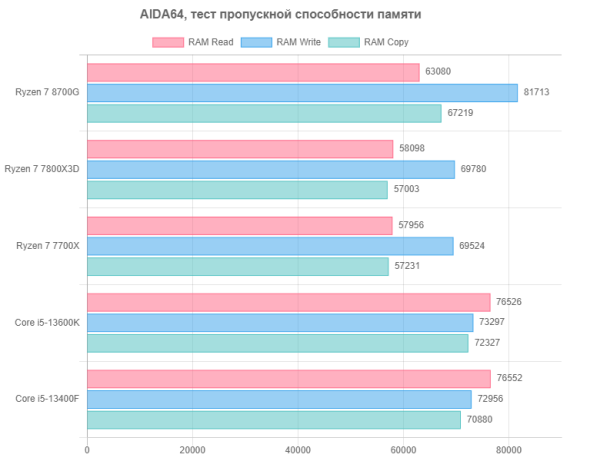
Both Ryzen 7000 variants with DDR5-5200 achieve read speeds of around 58 GB/s, while the 8700G reaches 63 GB/s, which is closer to the 16-core Ryzen 9 7950X3D. However, compared to Intel processors equipped with the same memory and similar XMP profile settings, these figures are not particularly outstanding. At the same time, the memory write speed of the Ryzen 8700G is significantly higher than that of chiplet Ryzens, and is also faster than both Core i5 processors. So, although AMD's DDR5 memory controller is not the best compared to Intel's, the top-end Zen 4 APU beats them in write speed.
For many years, increases in computing power have far outpaced increases in memory performance. Processors used increasingly complex caches to provide improved performance despite limited memory speeds. Both Intel and AMD use a three-level caching scheme: each core has a small L1 cache and a larger L2 cache, which helps reduce data access latency. The multi-megabyte L3 cache shared by multiple cores also plays an important role in ensuring fast data availability.
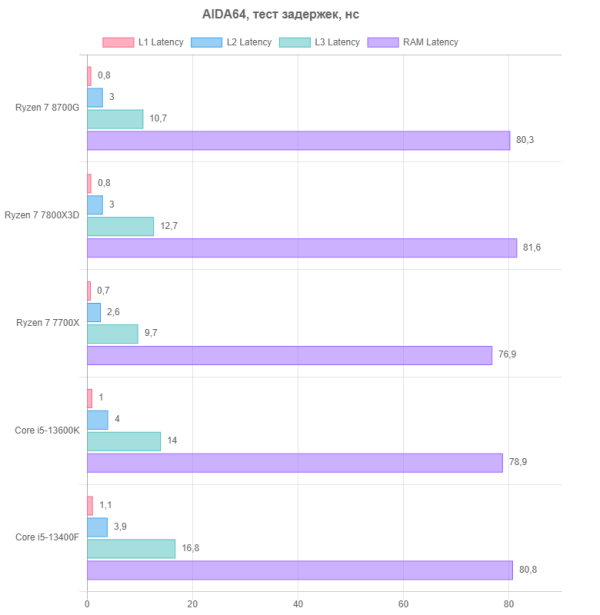
It is clear that the presence of an L3 cache on a separate chip increases the data access latency for the 7800X3D, but in general, the latencies of the cache subsystem of the first two levels for all Ryzen processors are quite similar in this test, differing only due to different clock frequencies and measurement errors. When compared with both competitor processors, the AMD APU in question shows the best latency values across all cache memory levels.
Latency values in the AIDA64 synthetic test results are in nanoseconds, and there may be some aspects that this package does not take into account. Therefore, we will additionally turn to the results from a similar Sandra test, which measures access latencies in clock cycles, without taking into account the increased clock speed of some models. In previous studies, we have already observed some interesting findings from this test.
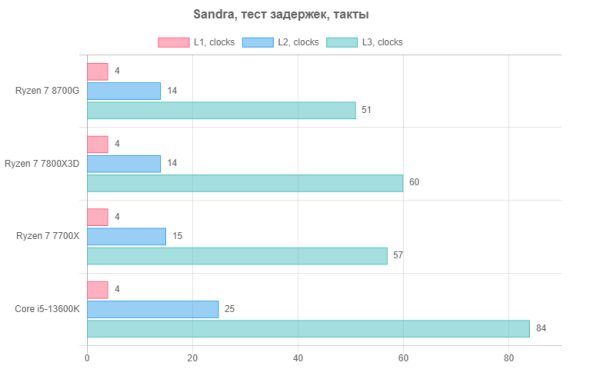
Exactly, the second cache latency test showed slightly different results. This is likely due to the Ryzen 7 8700G's smaller L3 cache, which resulted in slightly lower access latency compared to the Ryzen 7 7700X and 7800X3D. However, for the first two levels of cache memory the situation remains approximately the same for all Ryzen processors for obvious reasons. Comparatively, the only Intel Core i5 processor in this test is clearly inferior in terms of second and third level cache latencies.
When it comes to Core-to-Core Latency, the Phoenix monolithic Ryzen 7 8700G shows good performance across all eight Zen 4 cores, ranging from 6.5-7 ns within a single core to 17 .5-21.5 ns to others. This once again confirms that the Ryzen 7 8700G is built on a single cluster of eight cores. Monolithic chips eliminate some of the problems of transferring data between cores across the Infinity Fabric.
In addition to cache access latency, cache throughput is also important, especially for vectorized code. Despite the architectural changes in Zen 4, AMD engineers did not make significant changes to the main caches; their bandwidth remained the same as in Zen 3 and Zen 2. Improvements in L1 and L2 cache bandwidth come down to an increase in clock speed. The throughput of the L3 built into the compute chiplets has improved slightly, and the queue size between L2 and L3 has been increased to reduce latency. Let's look at the results of the throughput test of all levels of cache memory from AIDA64.
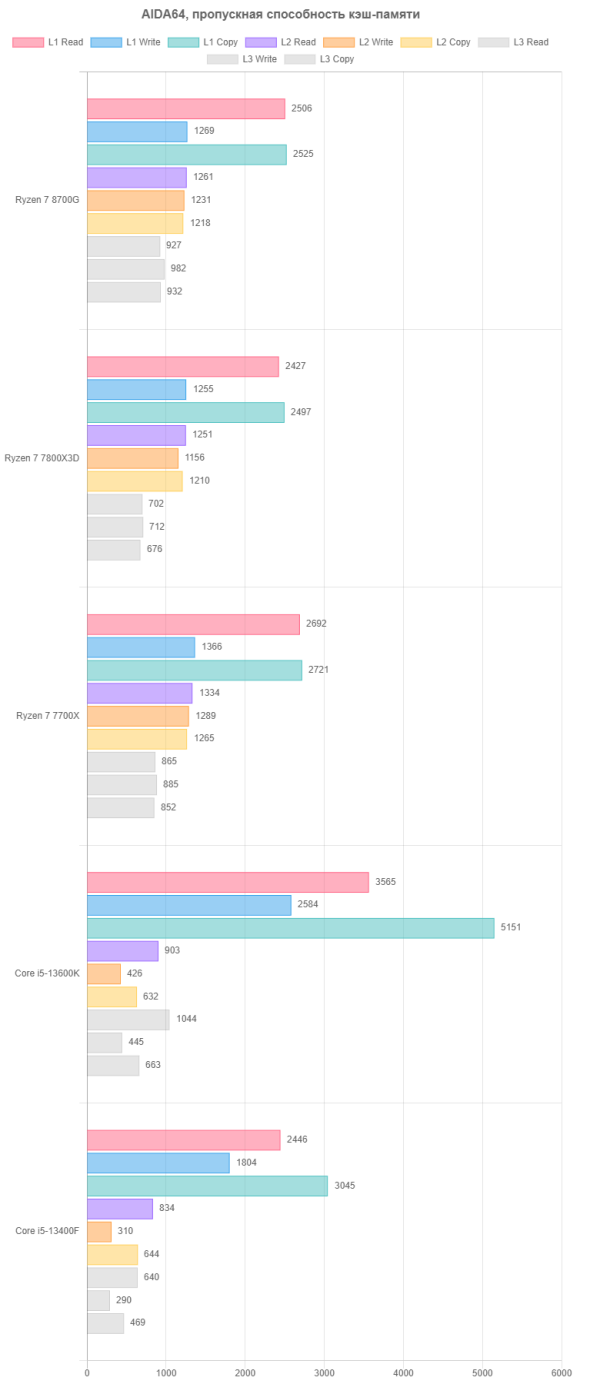
We've already noted that Zen 4 cache is faster at all levels than the previous generation, especially in terms of L3 cache. When comparing all Ryzen models, it is clearly noticeable that the Ryzen 7 7700X demonstrates slightly better memory bandwidth in the first two cache levels due to the increased frequency, while the 7800X3D lags behind in L3 speed. However, today the greatest interest is the fact that the Ryzen 7 8700G shows better results in terms of L3 cache speed, which is explained by its smaller size compared to other processors in the Ryzen 7000 family. The Intel processors we selected as competitors have a slightly more powerful L1 cache, but at the same time they are significantly inferior in throughput to the L2 and L3 caches.
Synthetic tests Sandra
Benchmarks from packages such as Sandra and AIDA64 can be useful for assessing low-level performance on specialized tasks, although they are intended primarily for a wide range of applications. These tests allow you to evaluate relative performance in various tasks and calculate an overall CPU Overall score based on all the results obtained. Unfortunately, the benchmark refused to run on the Core i5-13400F processor, so the results for this processor are not included in the tables.
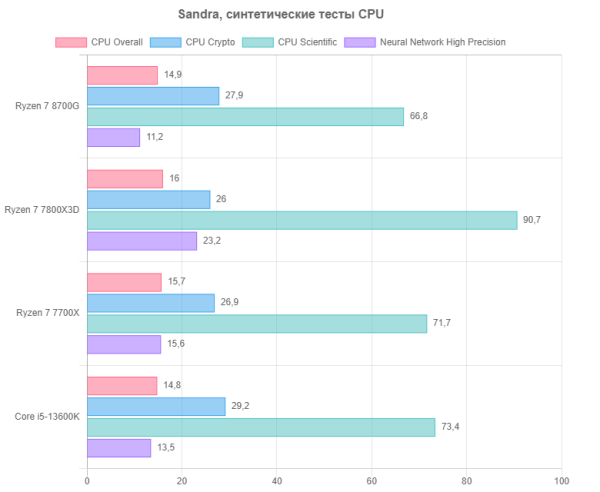
According to the results of this set of tests, the Ryzen 7 8700G turned out to be slightly weaker than other processors based on the Zen 4 architecture. This may be due to the use of mobile cores with a reduced frequency, as well as a smaller L3 cache. However, we were able to notice that Ryzen performed better in the cryptography subtest, perhaps due to faster cache performance, despite its smaller size. In other tests, the Ryzen 7 8700G failed, especially in neural networks. This is explained by the fact that the large amount of L3 cache on the Ryzen 7 7800X3D processor gave a significant increase in performance, while the APU has half the volume of the Ryzen 7 7700X.
The Ryzen 7 8700G's competitor, the Core i5-13600K, has a similar overall result to the APU, but has a slight advantage in compute performance in other subtests on this chart. However, moving on to multimedia tests, AMD usually demonstrates better performance there.
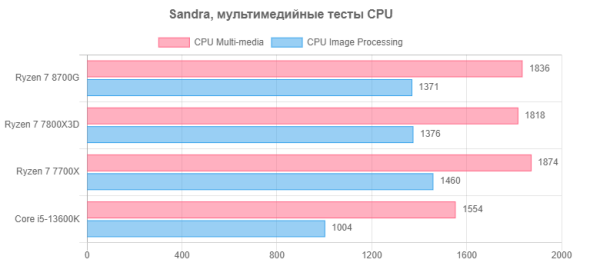
These tests represent computational performance when processing media data. In them, the new flagship APU showed speeds on par with the Ryzen 7 7800X3D, and both processors were slightly behind the Ryzen 7 7700X. In these tests, the size of the L3 cache does not affect the result, and the maximum frequency also has a less significant effect. The difference between the three Ryzen models in favor of the Ryzen 7 7700X is explained by its higher frequency. The Intel processor in these tests, despite the large number of cores and frequency, lags behind all Ryzen. Perhaps these specialized tests are better suited to AMD processors. Now let's look at tests from another universal package — AIDA64.
Synthetic AIDA64 tests
These are also synthetic tests that demonstrate performance in tasks with a certain specialization. For example, CPU Queen uses integer operations to solve a classic chess problem, and AES evaluates the encryption speed using the AES cryptographic algorithm.
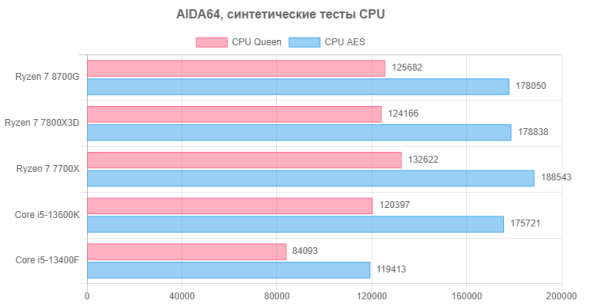
In these tests, increasing the clock speed and power limit helped AMD processors, which was previously less common compared to Intel Core processors. Even with fewer processing cores, all three Ryzen processors turned out to be faster than the Core i5-13600K, not to mention its younger model. The Ryzen 7 8700G hybrid processor, which we are reviewing today, lags behind the 7700X due to its low frequency, but is very close to the 7800X3D. The difference between them is small, as are the operating frequencies.

The first two subtests presented in the diagram use integer operations for image processing and information compression, and SHA3 is another cryptographic algorithm. Intel processors typically perform strongly in these tests, especially in image processing. The more powerful Core i5 processor outperformed all Ryzen models in the first and second tests, and achieved results similar to the Ryzen models in the third.
Even the low-end Core i5-13400F showed impressive performance in the first subtest, despite the lack of multi-threaded processing, which emphasizes the importance of memory speed. Today's 8700G APU outperformed regular Ryzen models in the first subtest thanks to slightly faster RAM and L3 cache performance. In the second and third subtests, it came close to the 7800X3D's results, although both of these processors fell behind the 7700X due to lower clock speeds.
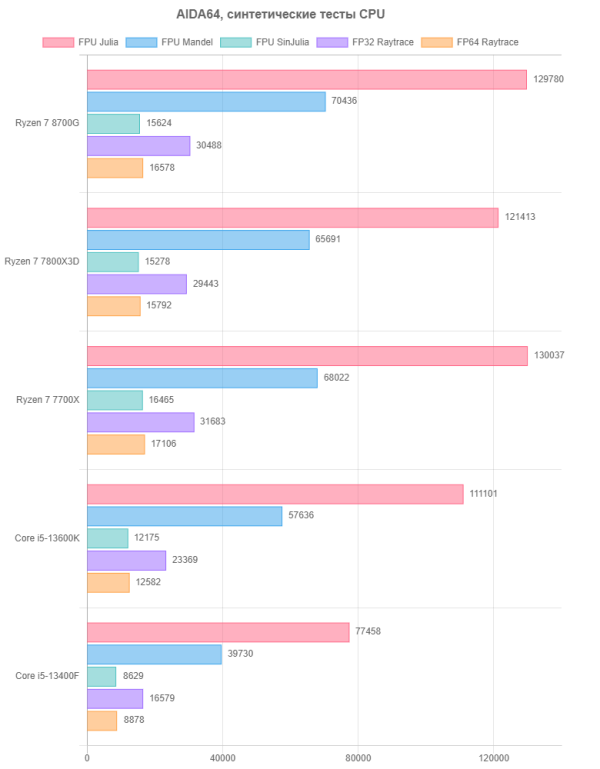
Benchmark CPU-Z
Another synthetic test that we included in this section is the core load test, which is close to the rendering tests. It is also useful for comparing single-threaded and multi-threaded processor performance. In the case of Ryzen processors, including the hybrid 8700G, the test version with AVX-512 was used, which slightly increased performance compared to competitor processors.
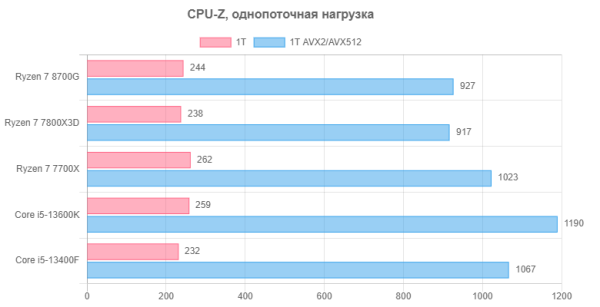
In peak single-threaded performance, AMD processors are generally inferior to Intel solutions, which is confirmed by the results of the CPU-Z test. The Core i5-13600K was particularly fast, especially when using AVX instructions. The lower maximum clock speed of the 8700G and 7800X3D compared to the 7700X resulted in a clear loss of speed in single-threaded performance. For her, the most important thing is the turbo frequency, which in their case is more limited. However, with a multi-threaded load, the difference may be smaller.
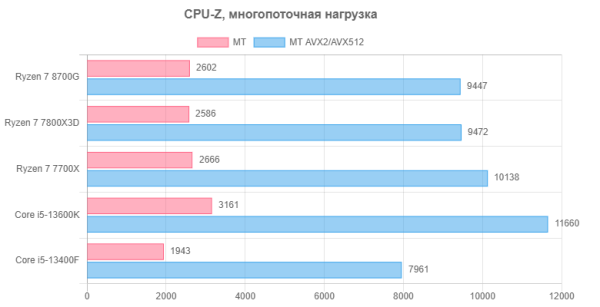
However, even in multi-threaded performance, the Ryzen 7 8700G lags behind the best of pure desktop processors, the 7700X, due to the reduced frequency and, most likely, lower power consumption. At the same time, they show very close results with the 7800X3D, which is explained by close frequencies, and all the caches are not so important here. Intel processors demonstrated results that differed by one and a half times, and the hybrid flagship APU Ryzen 7 8700G occupies approximately a middle position between the older Core i5-13600K model and the younger 13400F. The use of AVX512 instructions in this test gives a good boost to Ryzen processors, but this is not enough to catch up with the best Intel processors presented.
General tests
Let's move on to less artificial tests that evaluate system performance in various types of application tasks, and also provide an average value reflecting overall performance. An example of such tests is the PCMark 10 package. This approach has its advantages (simplicity of evaluation using a single value for an entire line of software) and disadvantages (an attempt to cover too wide a range of tasks, which is not always ideal), but in most cases processors are tested in it .

From previous materials we have already learned that most PCMark subtests do not use many threads, and performance is weakly dependent on the number of cores. It is most often determined by the CPU frequency and memory bandwidth, with a noticeable increase in the number of cores observed only in the gaming subtest. In this context, it is not surprising that almost all processors demonstrate similar results both in the overall test and in subtests, including performance in office tasks.
However, a couple of the least powerful processors stand out, including the Core i5-13400F and… Ryzen 7 8700G. Both of these processors performed relatively poorly in individual subtests, and although the 8700G is slightly faster, it is noticeably inferior to all others — the new product lags even behind the regular Ryzen 7 models, and the older Core i5 is ahead of it in all subtests. It seems that mobile cores, with their lower clock speeds and cache sizes, performed slightly less efficiently in almost every aspect.
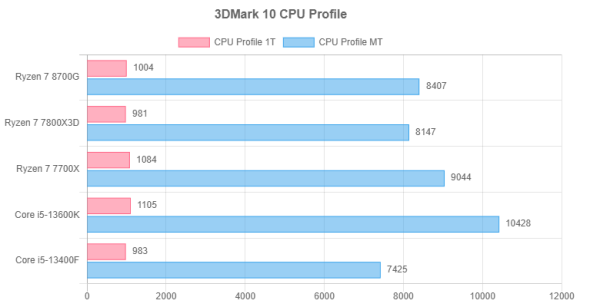
The second general performance test we looked at was the 3DMark CPU Profile, which focuses on gaming rendering speed. In this subtest, the Ryzen 7 8700G, surprisingly, is not inferior even to the 7800X3D, and is even ahead of it thanks to a slightly higher operating frequency. Naturally, the 7700X, with an even higher frequency, is the fastest of them all. In this particular test, cache memory does not provide an advantage, but rather an exceptionally high frequency is required.
Comparing the top eight-core APU with potential Intel competitors, you can see that the hybrid processor in question is inferior to the older Core i5-13600K model, both in single-threaded and multi-threaded calculations. This makes sense, given that Intel processors typically perform well in single-threaded tasks, and a large number of heterogeneous cores helps them in multi-threaded workloads. Compared to the 13400F, the 8700G has an advantage, although it is insignificant, but it is there. In real gaming scenarios, the situation will be somewhat different, since a larger cache becomes more important there, but the high frequency of the main cores is also important.
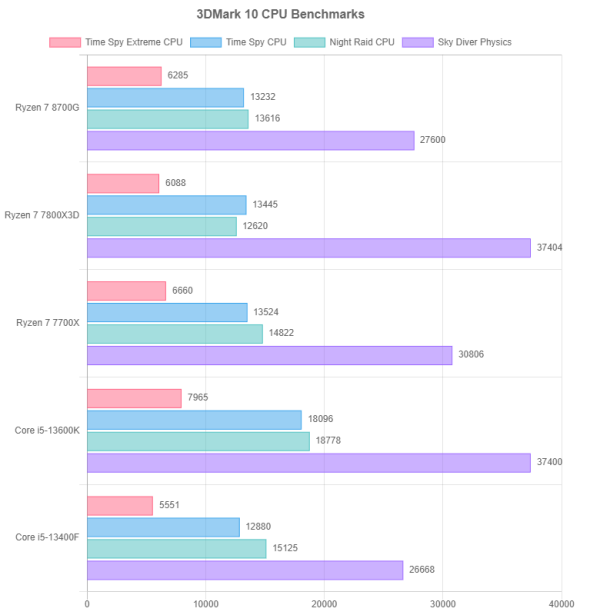
We've included a few more CPU tests from the 3DMark suite, which typically involve physics calculations and are capable of multi-threading, although with varying efficiency. The Ryzen 7 8700G trails the 7700X in most cases, but outperforms the 7800X3D with additional cache in half of the tests, which is in line with expectations.
As for Intel's rivals, the Core i5-13600K is always noticeably faster than the AMD APU we're reviewing today in these types of workloads. The architecture with a large number of processing cores and high frequency make Intel processors preferable for such tasks. Even the less powerful 13400F achieves fairly close results to the 8700G.

The last test in this section is the JetStream 2.0 browser benchmark, which evaluates the performance of JavaScript and WebAssembly code. To conduct the tests, we used an updated version of Microsoft Edge running on the Chromium engine. This test is not heavily dependent on multi-threading and is largely determined by the clock speed, especially in turbo mode. As a result, the Ryzen 7 8700G took an intermediate position, although it was slightly behind the 7700X, but ahead of the 7800X3D. The older of the supposedly competing Intel processors coped with the task a little better, and the younger one did a little worse, leaving our APU in the middle.
Rendering
Rendering tests are some of the most demanding on modern CPUs due to their multi-threaded nature in ray tracing. Processors try to maintain the highest possible frequency, which can lead to high power consumption and heat. Disadvantages of the cooling or power supply system may become noticeable in such tests. It is often necessary to maintain a stable ambient temperature for a fair comparison, as high-end processors can quickly reach maximum temperature and reduce frequency to reduce the load on the cooling system. Sometimes you have to run multiple test runs, cooling the processor between them.
AMD and Intel often use the Cinebench benchmark to compare the performance of their processors with competitors. These rendering tests best demonstrate the benefits of multi-core processors, which is why AMD has previously actively used the results of this test to demonstrate the superiority of its solutions. In response, Intel also began to focus on multi-threaded solutions in order to surpass its competitor in the number of computing cores and threads.

In such workloads, the dependence on the cache size may appear, but this depends on the specific implementation of the renderer. The Ryzen 7 8700G under review was slightly behind even the 7800X3D in single-threaded mode, and they showed similar results under multi-threaded workloads. Both processors were slower than the 7700X in this task due to their lower operating frequency in both single-threaded and multi-threaded modes.
The more powerful Core i5-13600K also significantly outperformed the Ryzen 7 8700G in both modes in this test, thanks to higher frequencies and more cores (and corresponding power consumption). While the younger model 13400F was close to the Ryzen 7 8700G in single-threaded mode, but lost in more difficult conditions. It is likely that in some games where single-threaded performance and a large amount of cache memory are important, the Ryzen 7 8700G may be less effective.

Test results in Blender showed that the Ryzen 7 8700G is inferior to the 7800X3D in all scenes, and the latter, in turn, is slower than the 7700X. This is because the extra L3 cache helps a little in this software, but it's the high clock speed that makes the biggest difference.
The 8700G was out of the list of leaders among AMD solutions in these tests, while the older Intel processor chosen for comparison showed itself very strongly, becoming the comparison leader. The Core i5-13400F, as usual, showed the least impressive results. Our APU under consideration ended up somewhere in the middle between them.
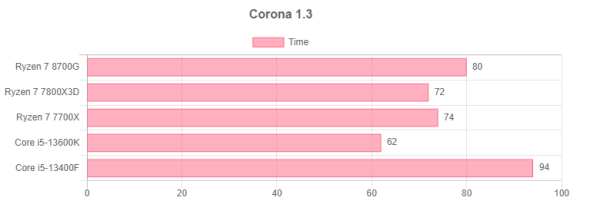
In the Corona rendering test, which measures the time it takes to render a single frame, the importance of cache memory became even more noticeable. In this case, the eight-core 7800X3D model with additional L3 cache turned out to be faster than all Ryzens, beating even the 7700X. Not surprisingly, the Ryzen 7 8700G, with its half the L3 cache compared to the 7700X, was inferior to this model. The older competitor Core i5-13600K was also significantly ahead of AMD's hybrid solution, while the younger 13400F was again the least productive.
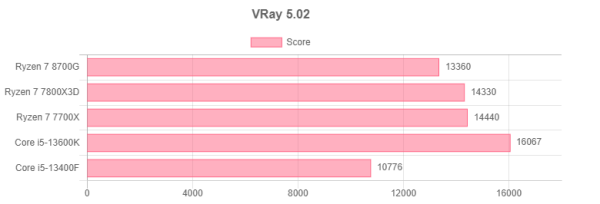
The latest benchmark related to 3D rendering is VRay. It measures the rendering speed of images for three scenes. The results of this test generally follow the trend seen in previous tests in the section. The Ryzen 7 8700G we're talking about today is behind both the 7700X, which runs at higher cores, and the 7800X3D, which has additional, larger cache. Thus, among the rendering tests there are more of those where the L3 cache size plays an important role, and the 8700G is not the best option in such conditions. It’s the same with Intel processors chosen as conditional competitors: the older 13600K is significantly ahead of the 8700G, while the 13400F turns out to be noticeably slower.
Working with photos and videos
This section of tests covers several programs for processing media, including photos and videos. These tasks already represent practical use cases, such as exporting hundreds of high-resolution RAW images, approximately 3 GB in size, to Adobe Lightroom Classic. These types of tasks are standard for many professional photographers.

In the photo processing test, the new AMD APU performed only slightly worse than the Ryzen 7 7700X, despite the fact that peak frequency is very important here, which is noticeably higher for a regular processor. However, the only processor with an additional L3 cache failed in this particular test. In Lightroom, the new APU again appeared to be in the middle between the Core i5-13600K and 13400F, which has become a common occurrence. Intel's performance in this particular software is traditionally high, while multi-threaded performance in Adobe Lightroom does not play a decisive role.

In the video editor of the same company, the situation looked completely different. We checked the rendering of a simple project in Full HD and 4K formats, which is a common task when preparing an edited video for streaming video services. In this context, the Ryzen 7 8700G was roughly on par with the 7800X3D — both processors operate at similar frequencies, which affects overall performance, while cache memory plays almost no role. The 7700X was faster than both, and the competition was pretty much in the same place: the Core i5-13600K was slightly ahead of AMD's new product, especially in the more complex 4K format, while the 13400F was significantly behind everyone else.

The next Handbrake test in line is a package for converting video data to other formats. We took the input video in H.264 format and transcoded it into H.265 format — a fairly typical task for modern users. In this test, the new Ryzen 7 8700G APU was marginally slower than the 7700X due to its slightly lower clock speed, but outperformed the 7800X3D with additional cache despite the slightly lower clock speed. The Core i5-13600K was the fastest among all AMD eight-core processors thanks to its strong single-threaded performance, while the 13400F came in last place in the ranking.The next Handbrake test in line is a package for converting video data to other formats. We took the input video in H.264 format and transcoded it into H.265 format — a fairly typical task for modern users. In this test, the new Ryzen 7 8700G APU was marginally slower than the 7700X due to its slightly lower clock speed, but outperformed the 7800X3D with additional cache despite the slightly lower clock speed. The Core i5-13600K was the fastest among all AMD eight-core processors thanks to its strong single-threaded performance, while the 13400F came in last place in the ranking.

In the second video transcoding test, using SVT-AV1 for AV1 encoding, we encountered a new open standard. The results of the new APU model were generally as expected: we saw a slight lag behind the 7700X, but the approach to the 7800X3D was noticeable. However, this time our conditional opponent turned out to be much faster. Optimization for a specific architecture is important here, and our design was not optimized for the new AMD processors. This led to the fact that our hero was inferior not only to the older Core i5-13600K (very much, by one and a half times), but also to the younger model 13400F. However, we know that this is the exception rather than the rule, and there are cases where the situation is reversed.
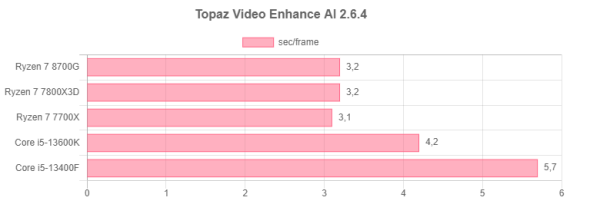
The last test in this section, Topaz Video Enhance AI, uses an application to improve video quality using artificial intelligence. This is a computationally intensive task that requires high-quality resolution upscaling from Full HD to 4K using the Artemis High Quality algorithm.
In this test, all Ryzen processors demonstrate the capabilities of Zen 4 cores using AVX-512 instructions. The cache does not play an important role here, so all AMD processors show very similar results, only the 7700X is slightly faster. The advantage over Intel processors is significant: the hybrid Ryzen 7 8700G is more than one and a half times faster than the Core i5-13400F, while the 13600K is significantly behind.
Cryptographic tests
Another important aspect of testing the performance of processors is their ability to solve cryptographic problems. Modern CPUs are capable of encrypting large amounts of information on the fly, and some support special instructions for popular algorithms such as AES. The first test is John The Ripper, an open source hash-based password recovery software that can take full advantage of modern processors.

In such tests, the number of processing cores and a powerful architecture with maximum clock speed are decisive. However, speed and cache size are also important, although their impact is noticeably less. The eight-core hybrid APU being reviewed today is inferior to its CPU counterparts with the same number of cores in all tests. The 7700X and even the 7800X3D are faster than the hybrid, probably mainly due to the smaller L3 cache and lower clock speed compared to the former.
However, the new flagship APU is ahead of its most powerful competitor, Intel, in two out of three subtests, losing only in the Blowfish algorithm. The younger model Core i5-13400F turns out to be noticeably slower than all the others, showing the worst result in comparison.

VeraCrypt is on-the-fly encryption software that uses multiple data encryption algorithms and supports CPU hardware-accelerated encryption. We used a 1GB buffer in our tests and got the expected results for the trio of Ryzen processors, close to their maximum operating frequencies for both Twofish and AES. When compared with Intel processors, the new AMD hybrid processor was inferior to the older model — Core i5-13600K, ahead of only the younger 13400F. Typically, Intel performs quite strongly in this type of test due to the large number of cores.
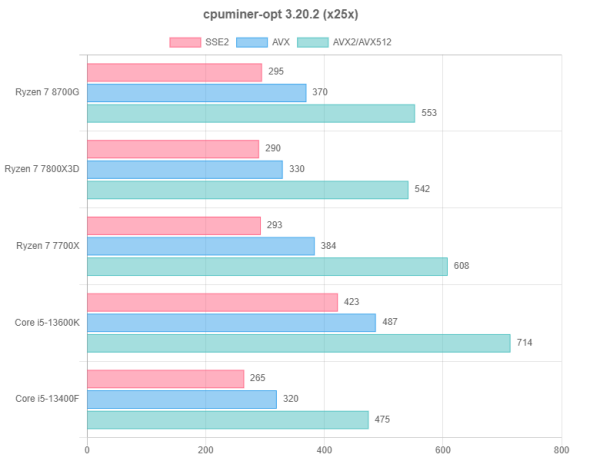
The third and final cryptographic test is cpuminer-opt, a CPU mining program that also uses cryptographic calculations and is well optimized for modern CPUs. For tests, we chose the x25x algorithm, used in some cryptocurrencies, and compared the best result from several optimized miner options using instruction sets: SSE2, AVX2, AVX-512, as well as hardware support for AES and SHA.
The Ryzen 7 8700G hybrid processor performed as expected, losing to the regular 7700X processor, but slightly ahead of the 7800X3D due to the differences in frequencies between them. Compared to the Core i5-13600K and 13400F, Intel processors performed stronger, despite the speed increase from using AVX512 instructions in all AMD solutions. However, due to the larger number of processing cores, including additional effective ones, the younger version of the Core i5 turned out to be closer to the 8700G in question than the older 13600K, which won in all categories.
Compression and decompression
Compressing and decompressing data in archives is a familiar procedure for most users, and one of the most popular modern archivers is WinRAR. We tested using the benchmark built into the archiver, which measures the maximum data compression speed.
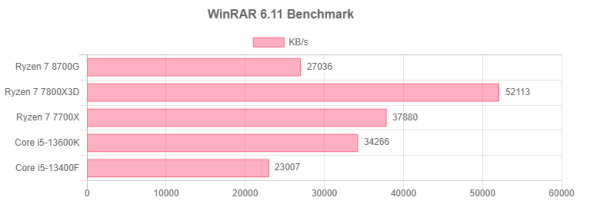
In WinRAR, AMD processors have always been highly efficient at compressing information, especially models with an additional cache, which received a significant performance boost in the built-in benchmark. For example, the 7800X3D was significantly ahead of the 7700X without cache. This indicates that cache size has a significant impact on the test result, making the Ryzen 7 8700G less competitive due to its smaller L3 cache compared to the 7700X.
Indeed, in this test the 7800X3D turned out to be twice (!) faster than the 8700G in question, and even the 7700X outperformed the APU by 40%, which is explained by the reduced L3 cache size. Moving on to Intel processors, the Core i5-13600K was also significantly ahead of the flagship hybrid, with the 13400F delivering the slowest performance. Thus, the 8700G finds itself between two Intel processors, this time closer to the weaker model.
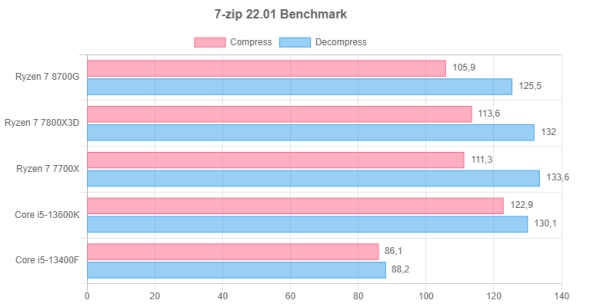
The second archiver, 7-zip, may be less common, but attracts attention for its support for a more efficient and demanding compression method. Unlike WinRAR, the impact of a large cache on performance in this case is not so significant. The performance gain of the 7800X3D over the 7700X in data compression is small. However, the results of the new Ryzen 7 8700G hybrid processor are still slightly lower than those of both CPUs, although not significantly. But the top APU has a noticeable advantage over the junior Core i5-13400F and is slightly inferior to the 13600K, especially when decompressing data. In the case of compression, Intel's advantage is due to the number of cores, their clock speed and a significant amount of cache memory.
Math tests
For math problems, we looked at the Y-Cruncher program for calculating the number π. Of particular interest to us is this program's support for the AVX-512 instruction set, as well as optimization for the Zen 4 architecture in the latest version. We tested using this version to verify the results.
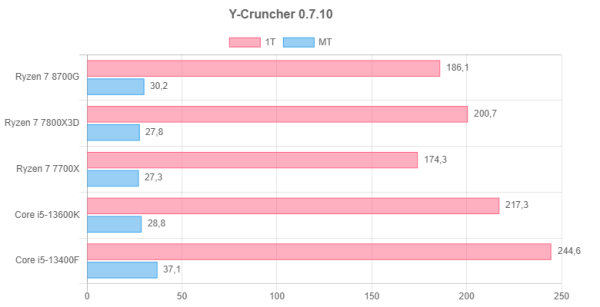
We tested the calculation of a billion digits of π in single-threaded and multi-threaded modes. In a single-threaded task, the Ryzen 7 8700G performed slightly worse than the 7700X due to the high maximum frequency of the latter's cores. However, it outperformed the 7800X3D with an even lower peak clock. In multi-threaded mode, which is more important in general, the advantage over the 7800X3D was lost, and the new product in question lost to the processor with an additional cache. It's likely that all Ryzens in multi-threaded tasks are limited by the established power consumption limits.
Surprisingly, even the Core i5-13600K was lagging behind today's hero in single-threaded mode and was marginally faster in multi-threaded mode. This is unexpected, given that the older Intel processor has more processing cores and a high operating frequency. Apparently, optimizations for Zen 4 and AVX512 in this software are done really effectively.
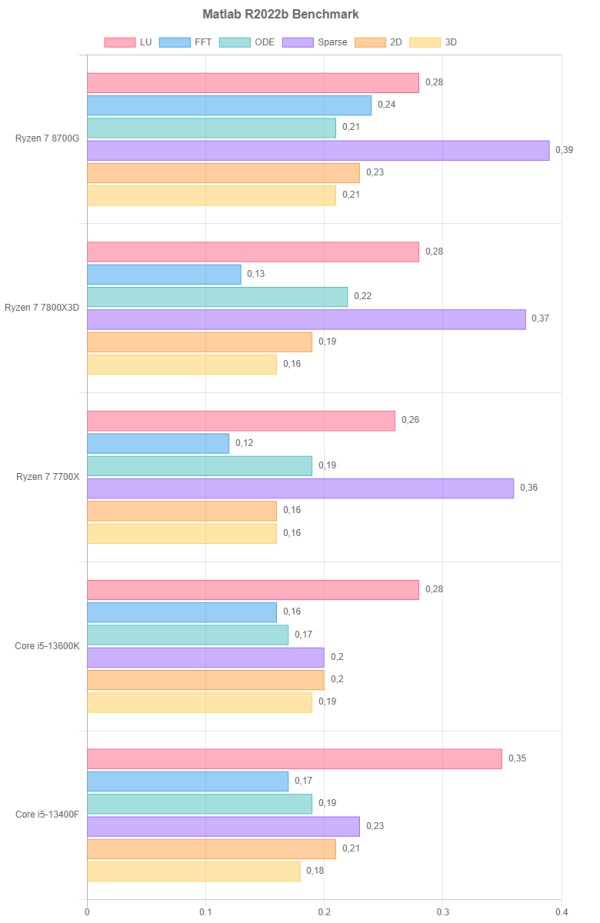
The built-in benchmark in Matlab is not a reliable test, as it is outdated and finishes too quickly on modern processors, and its results can vary widely. However, the Ryzen 7 8700G's performance is noticeably different from the 7700X and 7800X3D in some tests, likely due to its fast, large cache and core clock speeds.
Comparing the results of the new APU with the Core i5 is also difficult, since in some subtests Intel processors have a clear advantage, and in others — AMD. It is more reliable to consider the results from the scientific calculations section of our 2020 test methodology, which includes a longer and more revealing test in the same Matlab package.
Gaming performance with discrete graphics card
Although hybrid APUs are generally not designed to work with discrete graphics cards, testing integrated graphics for these processors remains relevant. This may be useful for those who plan to use a more powerful discrete GPU in the future. We have already conducted a separate study on gaming performance and found that even in modern games there is often no significant difference between processors with different numbers of cores, provided the clock speed is similar. A more important factor is the large amount of fast cache memory, which is typical for the Ryzen 7 7800X3D, as well as the high clock speed of the processing cores. Let's look at the average data for our test set of a dozen games of various genres and several processor models.
| Avg. FPS | Min. FPS | Average, % | Min., % | |
|---|---|---|---|---|
| Ryzen 9 7950X3D | 309,1 | 203,6 | 100% | 100% |
| Ryzen 7 7800X3D | 299,2 | 196,5 | 97% | 97% |
| Ryzen 7 8700G | 225,9 | 144,1 | 73% | 71% |
| Ryzen 7 7700X | 272,4 | 175,9 | 88% | 86% |
| Ryzen 5 7500F | 250,2 | 159,7 | 81% | 78% |
| Ryzen 9 5950X | 244,9 | 157,1 | 79% | 77% |
| Core i5-13600K | 282,7 | 188,5 | 91% | 93% |
| Core i5-13400F | 241,8 | 157,9 | 78% | 78% |
It is obvious that even in Full HD resolution with average graphics settings, the slowest processors are significantly inferior in performance to powerful CPUs. Among the least productive was the hybrid Ryzen 7 8700G, lagging behind the best solutions by more than a quarter, which is a significant gap. However, even at this level of performance — slightly lower than the Ryzen 9 5950X and Core i9-11900K — frame rates remain quite high, exceeding 200 FPS on average. Thus, in practical conditions the difference may not be noticeable.
However, we have to admit that in games, the amount of fast cache memory plays an important role. This is clearly visible even when comparing the Ryzen 7 7800X3D and 7700X, where the difference is up to 14%. The 8700G hybrid processor has half the L3 cache volume, which explains its position as the weakest processor among those presented in this context. However, the effect of L3 cache size on game speed is not always directly proportional. Some games such as Far Cry 6, F1 2022, Watch Dogs: Legion and Hitman 3 benefit significantly from more L3 cache, while strategy games such as Civilization VI and Total War Troy benefit little by little from increasing the cache size, but prefer a larger number of fast cores.
| Avg. FPS | Min. FPS | Average, % | Min., % | |
|---|---|---|---|---|
| Ryzen 9 7950X3D | 152,4 | 115,5 | 100% | 100% |
| Ryzen 7 7800X3D | 151,0 | 113,3 | 99% | 98% |
| Ryzen 7 8700G | 140,2 | 103,0 | 92% | 89% |
| Ryzen 7 7700X | 150,1 | 110,0 | 98% | 95% |
| Ryzen 5 7500F | 143,0 | 103,4 | 94% | 90% |
| Ryzen 9 5950X | 145,8 | 105,3 | 96% | 91% |
| Core i5-13600K | 151,6 | 114,8 | 99% | 99% |
| Core i5-13400F | 147,4 | 109,6 | 97% | 95% |
In more demanding conditions for a discrete GPU, the difference between processors was expectedly reduced to a minimum. If previously the Ryzen 7 8700G was inferior to the 7700X by about 20% in Full HD at medium quality settings, then at a resolution of 2560x1440 and maximum settings this gap was reduced to only 7%. The differences between 150 FPS and 140 FPS, or even 110 FPS and 103 FPS, are almost impossible to notice with the naked eye.
The top-of-the-line eight-core Ryzen 7 7700X delivers over 20% better gaming performance than the Ryzen 7 8700G. Even the more affordable Ryzen 5 7500F performs slightly better than the APU in question. And the Core i5-13400F also outperforms the top-end Ryzen 8000G series processor, not to mention the 13600K. This confirms that APUs are not the optimal choice for discrete graphics use. In such cases, it is better to choose a regular processor, be it AMD or Intel, which will cope more efficiently in systems focused on discrete video cards.
While the gaming performance of the Ryzen 7 8700G with discrete graphics remains acceptable, it is far from impressive. However, APUs can still be useful if you're on a budget or planning an upgrade by using the integrated graphics core first and then adding a higher-end discrete graphics card. However, purchasing an APU for use with powerful discrete graphics does not initially make sense.
Gaming performance with integrated graphics
For obvious reasons, the APU integrated graphics testing section is one of the most important. The performance gain of the Ryzen 8000G integrated graphics compared to the previous Ryzen 5000G series is quite obvious thanks to the transition from Vega graphics architecture to RDNA 3. For example, in games such as Cyberpunk 2077, at medium settings and Full HD resolution, the performance increase is about 40% when compared top solutions Ryzen 7 8700G and Ryzen 7 5700G — a very impressive result. The use of FSR scaling technology within AMD FidelityFX further increases this gain. However, in less demanding games the difference may be smaller — approximately 20%-30%.
We benchmarked the performance of the Ryzen 7 8700G's integrated graphics core against the integrated GPUs in top-end desktop processors such as the Ryzen 9 7950X and Core i9-13900K, as well as several discrete graphics cards of varying availability and price, ranging from the GeForce GTX 1050 Ti to the RTX 3050. This is due to the high price of the flagship APU, which allows the user to purchase a more affordable processor in combination with a video card, for example, a GTX 1650 or Radeon RX 6600, which may be more advantageous in terms of price-performance.
For clarity, we have prepared average results for a dozen games, including both modern and demanding ones, such as Cyberpunk 2077, and older and lighter loads, for example, F1 2022. Game resolutions cover the popular Full HD and the compromise 1366x768 to take into account different performance levels of integrated GPUs. Game graphics settings ranged from low to medium based on each game's requirements to ensure acceptable frame rates on all GPUs tested.
| 1366×768 | Avg. FPS | Min. FPS | Average, % | Min., % |
|---|---|---|---|---|
| Ryzen 7 8700G | 105,5 | 78,9 | 100% | 100% |
| Ryzen 9 7950X | 30,6 | 24,8 | 29% | 31% |
| Core i9-13900K | 31,5 | 24,9 | 30% | 32% |
| GeForce GTX 1050 Ti | 86,5 | 68,4 | 82% | 87% |
| GeForce GTX 1060 | 120,7 | 88,8 | 114% | 113% |
| GeForce GTX 1650 | 128,7 | 103,0 | 122% | 131% |
| GeForce RTX 3050 | 175,1 | 133,6 | 166% | 169% |
| Arc A310 | 91,9 | 70,5 | 87% | 89% |
Let's start by looking at the results at low resolution. It is obvious that the video cores built into processors cannot run games even under such modest conditions. Average values around 30-31 FPS, with minimum values around 25 FPS, make the gameplay possible, but not very enjoyable. It should be noted that these are averages, and some games simply cannot use the integrated graphics on the Ryzen 9 7950X and Core i9-13900K, regardless of resolution.
In contrast, the integrated graphics core in the Ryzen 7 8700G hybrid processor reviewed today behaves completely differently. Thanks to a more powerful GPU compared to the mentioned processor models, the Ryzen 7 8700G achieves over 100 FPS on average, with a minimum of 79 FPS. This clearly indicates that it is possible to increase the game's resolution to the popular Full HD while keeping graphics settings at low to medium levels.
| 1920×1080 | Ortalama FPS | Min. FPS | Ortalama, % | Min., % |
|---|---|---|---|---|
| Ryzen 7 8700G | 68,1 | 53,6 | 100% | 100% |
| Ryzen 9 7950X | 18,2 | 15,2 | %27 | %28 |
| Çekirdek i9-13900K | 20,0 | 16,1 | %29 | %30 |
| GeForce GTX 1050 Ti | 57,3 | 46,2 | %84 | %86 |
| GeForce GTX 1060 | 82,9 | 64,5 | %122 | %120 |
| GeForce GTX 1650 | 85,7 | 69,7 | %126 | %130 |
| GeForce RTX 3050 | 118,1 | 94,3 | %174 | %176 |
| Ark A310 | 59,6 | 46,8 | %88 | %87 |
Weak built-in GPUs in conventional processors really remain out of competition — their performance in the region of 15-20 FPS in such conditions looks simply ridiculous. But is the integrated core performance enough for the new Ryzen APU? Judging by the average indicators — quite. Average 68 FPS and minimum 53 FPS allow you to play comfortably. Moreover, in many cases it is even possible to increase the graphics settings to medium or even high, unless we are talking about the most modern and demanding games.
For clarity, let's determine what graphic settings will ensure comfortable gaming with an average frame rate of around 40-50 FPS and a minimum frame rate of at least 30-35 FPS — the so-called “console” conditions (considering that on younger models of game consoles the frequency is 30 FPS is a standard). Thus, if the player does not need constant 60 FPS, he can play with the following graphics settings:
| Permission | Settings | FSR | Min. FPS | Avg. FPS | |
|---|---|---|---|---|---|
| Year 1800 | 1920×1080 | High | — | 35 | 45 |
| Chernobylite | 1920×1080 | High | Quality | 32 | 45 |
| Cyberpunk 2077 | 1920×1080 | High | Balanced | 30 | 42 |
| DiRT 5 | 1920×1080 | High | — | 33 | 42 |
| F1 2022 | 1920×1080 | Ultra High | — | 43 | 50 |
| Far Cry 6 | 1920×1080 | Ultra | — | 38 | 42 |
| Hitman 3 | 1920×1080 | High | — | 30 | 55 |
| Tomb Raider | 1920×1080 | High | — | 37 | 43 |
| Total War Troy | 1920×1080 | Ultra | — | 35 | 43 |
| Watch Dogs Legion | 1920×1080 | High | — | 32 | 45 |
Thus, even in less modern, but still quite demanding games by today's standards, the Ryzen 7 8700G allows you to play at high and even very high graphics settings in Full HD resolution. This achievement is unique, since no integrated video core has previously provided such performance. For example, the Ryzen 7 8700G outperforms even the GTX 1050 Ti (by 15%) and almost on par with the GTX 1060 (by 20%) — video cards that are still popular and widely used in home PCs.
Although the Ryzen 7 8700G is inferior to more powerful discrete graphics cards such as the GTX 1650 or RTX 3050, it is still ahead of the Intel Arc A310 and is a significant achievement for AMD. This confirms the constant progress in CPU and GPU performance within the APU.
However, the main question remains how sufficient the gaming performance of the APU will be to completely abandon the discrete video card. It depends on user preference and performance standards. In most cases, the Ryzen 7 8700G provides acceptable frame rates, but does not always reach 60 FPS at medium settings and Full HD. Some games, such as League of Legends and Dota 2, can run at high performance, but more demanding games, such as Alan Wake 2 and Cyberpunk 2077, may experience slower performance.
However, the Ryzen 7 8700G is a significant breakthrough and a great choice for those looking for a budget solution with decent gaming performance. Of course, for users who need maximum CPU performance, or who want to play the most demanding games at high graphics settings, other, more powerful solutions may be suitable. But overall, the Ryzen 7 8700G provides excellent value for money, delivering gaming experience without additional discrete components.
Power consumption and temperature
Assessing the power consumption of modern processors is challenging due to differences between manufacturers' estimates and actual real-world performance. Peak power consumption is usually determined by TDP (thermal power), but for high-end processors, especially hybrid models, it can be significantly higher than rated values due to various overclocking technologies.
The new Zen 4 architecture and AM5 platform have increased the performance of AMD processors while increasing power consumption and temperatures. For example, the Ryzen 7 8700G APU has a power consumption rating of 65 watts on average and up to 88 watts at peak. However, in real conditions its power consumption at full load can exceed these values, reaching more than 90 W.
The use of STAPM power management technology, designed to prevent laptops from overheating, may cause performance issues on Ryzen 8000G desktop APUs due to reduced power consumption after prolonged use. However, updating the BIOS firmware can solve this problem by disabling STAPM by default and ensuring stable power consumption for a long time.
Thus, despite some technical difficulties, modern APUs such as the Ryzen 7 8700G offer excellent performance at reasonable power consumption levels, especially after making appropriate adjustments to the BIOS settings.
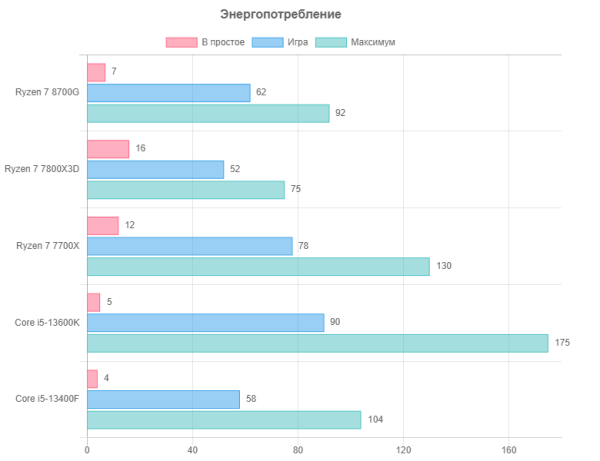
Let's look at the power consumption of processors in three different scenarios: idle, gaming and under maximum load. In game mode, the game Hitman 3 with the Dartmoor test scene was used to create the load, which loads both the video card and the system's central processor.
When analyzing the data, it became clear that the TDP and PPT power consumption limits for the Ryzen 7 8700G were not exceeded. In practice, this APU consumes even a little more power than expected. The maximum consumption was around 92 W, while the 7800X3D and 7700X had 75 W and 130 W respectively. The maximum consumption level was slightly below the limit value of 88 W.
In terms of energy efficiency, the Ryzen 7 7800X3D is even superior to the APU in question, despite not taking into account the powerful integrated video core. However, the Ryzen 7 8700G performs well overall compared to the 7700X. In game mode, the consumption of all processors drops noticeably, and in this scenario the APU consumed about 62 W, which is lower than the consumption of the Core i5-13600K.
Thus, the energy efficiency of the Ryzen 7 8700G is assessed as mixed. At idle, its consumption is close to that of its competitor, which is likely due to its mobile architecture. However, in general, the processor showed good results compared to its analogues.
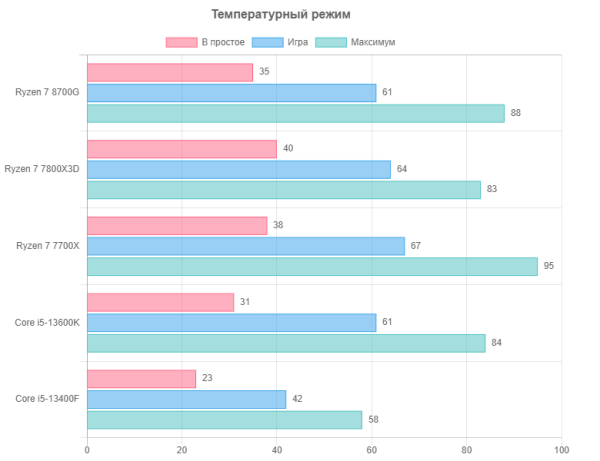
Regarding temperature conditions, the Ryzen 7 8700G hybrid processor showed fairly good results compared to other AM5 platform processors. In rendering conditions, the core temperature was 88°C, and in game mode it slightly exceeded 60°C. It should be noted that all processors used a powerful liquid cooling system with a 360 mm radiator and three powerful fans. Although an air cooler, like the one supplied, will do the job, temperatures will be higher, and the new APU cannot be considered completely cold. However, the fact that it is less hot than the 7700X is already a plus.
In idle mode, the temperatures of all processors were low: for the Ryzen 7 8700G they were 38-40°C, and for Intel processors — only 23-31°C. AMD's new APU came close to its competitors, achieving temperatures of 35°C in these conditions. In gaming mode, almost all processors ran moderately hot, and all Ryzens, including the Core i5, showed similar temperatures in the 61-67°C range. Only the Core i5-13400F stood out with lower temperatures, but it is also the least efficient of the bunch.
conclusions
We've already seen from AMD's previous hybrid solutions that they offer strong gaming performance for their price. The Ryzen 8000G is no exception. The top-end Ryzen 7 8700G offers powerful integrated graphics comparable to previous generations of discrete graphics cards, making it attractive for building gaming PCs without the need for a separate graphics card.
Conventional mainstream Ryzen 7000 processors with integrated graphics based on RDNA 2 architecture cannot provide enough power for modern games. In this context, the latest APUs such as the Ryzen 7 8700G provide acceptable performance for Full HD gaming at medium quality settings.
The new APUs also feature low power consumption and high energy efficiency, thanks to a monolithic chip and an improved manufacturing process.
However, despite the advantages, the new APUs are noticeably more expensive than their predecessors, which makes previous generations of Ryzen 5000G more attractive to users on a limited budget. Additionally, there are competing processor and graphics card combinations on the market that offer higher performance or lower prices.
Overall, the new Ryzen 8000G APUs are aimed at budget gaming PCs without discrete graphics cards and offer significant performance gains over previous generations. However, the choice between them and previous models may depend on the individual needs and budget of the user.
For example, a system build with an Intel Core i5-13400F processor and a GeForce GTX 1650 graphics card may offer a better combination of price and performance comparable to what the integrated graphics of the Ryzen 7 8700G offers. Even a more affordable combination like a Core i3-13100 and GeForce GTX 1050 Ti can offer similar gaming performance for less money. There is also an option with the Ryzen 5 7500F and Radeon RX 6600, which is also cheaper and provides almost identical results. Of course, each of these combinations has its own characteristics and disadvantages. For example, an Intel-based system with Nvidia graphics will consume more power than an APU, which can be an important factor in your selection.
In general, the market position of new APUs is not as optimistic as expected. They remain expensive compared to alternative solutions, especially considering the cost of the platform and memory. This makes previous generations of Ryzen 5000G more attractive to budget users. Despite the promises of the AI accelerator, its relevance on desktop PCs is now a question mark, and support for new platforms and memory only adds to the overall cost of the system.
As a result, APUs remain a niche product, and their market position suffers from high costs and competition from other CPU and graphics card combinations. The technical capabilities of the Ryzen 7 8700G are impressive, but its market position remains unsatisfactory due to its high cost and the availability of more attractive alternative solutions.


